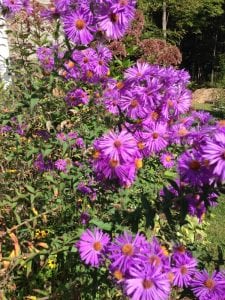By Pamela Doan
With all the bad news about climate change, gardening can be a powerful way to feel like your efforts matter. Our yards are spaces where our personal choices can be positive and restorative.
Here’s my vision for a yard that absorbs and holds carbon dioxide (CO2), which keeps it out of the atmosphere, where it contributes to global warming.
A low-carbon-footprint landscape includes:
Small areas of lawn that are used for specific recreational purposes.
Native plants that provide habitat for birds, wildlife and pollinators. For example, native milkweeds like butterfly weed (Asclepias tuberosa), common milkweed (Asclepias syriaca) and swamp milkweed (Asclepias incarnata) are important habitat for monarch butterflies, in particular. Losses of this plant across the country have led to severe declines in monarch populations.
Water conservation methods. For example, drip irrigation for vegetable gardens, drought-tolerant shrubs and perennials, and mulch to cover soil and retain moisture.
Healthy soil amended with organic materials like compost holds CO2. Make your yard into a carbon farm by organically enriching the soil. Research is showing that soil’s ability to sequester CO2 can play an important role in lowering greenhouse gas emissions, but we have to treat it right.
Diverse plantings — color, scent, bloom time — that offer value to the ecosystem all year long. Monocultures of plants and trees, the typical suburban landscape, don’t offer habitat value.
Layers of plantings that mimic natural settings. Envision a landscape with canopy trees such as oak, maple, pine and birch; understory trees like redbud, witchhazel and shadbush; woody plants like serviceberry, ninebark and native oakleaf hydrangea; flowering perennials like asters, goldenrod and bee balm; and, just below that, a groundcover layer like some native sedges and strawberries.
Composting to keep food waste like vegetable and fruit scraps, coffee grounds and eggshells out of a landfill, where they turn into methane as they decompose, which contributes to greenhouse gas emissions. The EPA estimates that 30 percent of all materials sent to landfills are organic materials like food waste and lawn clippings that could be composted.
People-powered or electric-powered equipment, not gas-powered lawn mowers, trimmers, leaf blowers, etc. Gas-powered lawn equipment is a major source of pollution, emissions and a major contributor of harmful ozone. A lawn mower running for one hour can release the same amount of CO2 as driving a car for hundreds of miles.
Soil that isn’t broken up by rototillers, shovels or heavy equipment. Keep microbial communities in soil intact by leaving them alone. Every time a tree is cut down or soil is plowed, all its CO2 that was stored is released into the atmosphere.
Trees to shade living spaces in summer to reduce air-conditioner usage.
A rain barrel connected to a gutter drain pipe to collect water for hot summer weeks without precipitation. A 1,200-square-foot roof will yield 320 gallons of water when just a half inch of rain falls.
More tips
Grow vegetables for food. Most supermarket produce travels 1,500 miles from farm to consumer. Locally sourced and homegrown produce reduces the carbon emissions produced by shipping. It also eliminates packaging.
Avoid bare ground. Flowerbeds that die back in the winter can be mulched and plant stalks left until spring. Garden beds can be planted with cover crops like rye or winter wheat to prevent erosion and add nutrients.
Create a rain garden to keep stormwater on your property. When we have heavy rainfalls, water runs off instead of soaking into the ground and takes with it any chemicals it catches along the way. Spilled gas, oil leaks, fertilizers, herbicides and pesticides are all washed into waterways. A rain garden uses roots of plants that like wetter conditions to capture and contain more water so that it can soak into the ground.
